Every Tribe, Every Tear:
"The Healing of the Nations"
For Sunday April 29, 2007
Lectionary Readings (Revised Common Lectionary, Year C)
Acts 9:36–43
Psalm 23
Revelation 7:9–17
John 10:22–30
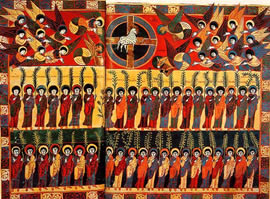 |
The multitude in heaven. |
There are sixty-six books in the Christian Bible, none of which has provoked more controversy, esoteric speculation, or misunderstanding than the very last one—Revelation. In the fourth century notable scholars like Chrysostom and Eusebius hesitated to include Revelation in the canon. The Protestant reformer Martin Luther described it as "neither apostolic nor prophetic. My spirit cannot accommodate itself to this book. I stick to the books which present Christ to me clearly and purely." John Calvin wrote commentaries on every book in the New Testament except Revelation. Today, among Eastern Orthodox believers Revelation is the only book that they don't read in their public liturgy.
Apocalyptic literature like Revelation is difficult to decipher even for careful readers. As a genre of writing that flourished from about 200 BC to 200 AD among both Jews (cf. Daniel 7–12) and Christians (cf. Mark 13), apocalyptic literature is characterized by visions, symbols, numerology, surreal beasts, and sea monsters. Even a biblically illiterate person knows that "666" (13:18) portends something ominous. But what does a gigantic red dragon with seven heads, ten horns, and seven crowns mean (12:3), or all of Revelation's cosmic calamities?
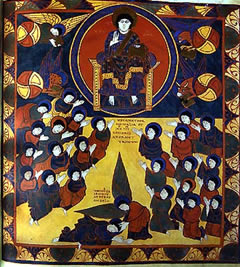 |
Celestial creatures worship God. |
Others complain that Revelation is too negative about the present, earthly world, and too focused on a future, heavenly world. But you might think differently if Roman emperors like Nero or Domitian had slaughtered your family, or if Janjaweed militia (literally, "devils on horseback") in Darfur had raped your women, strafed your village with jets, then burned it to the ground. For people like this hell has come to earth. And therein, I think, lies one key to making sense of Revelation.
In contrast to rich, white Christians in the west, poor Christians in Latin America, Asia and Africa know all too well about corrupt dictators, mass displacements, starvation from forced famines, ethnic wars, political repression, crushing debt, and grinding poverty. They read the apocalyptic themes of a book like Revelation as directly relevant to their daily lives. Divine intervention, healing, liberation, dreams, visions, miracles, and prophecies are lived realities rather than deconstructed myths for these Christians. Whether in ancient Rome or in modern Zimbabwe, the book of Revelation articulates the longing of people for God to intervene in human history and to make right all wrongs: "How long, O Lord, until you judge the inhabitants of the earth and avenge our blood?" (6:10).
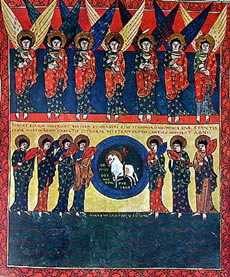 |
Seven angels with seven plagues. |
In Revelation, the Roman empire embodies and epitomizes all the forces of social violence, political imperialism, religious persecution, economic exploitation, and cultural hubris that wreak so much devastation in history. It's not clear which emperor ruled when John wrote from his banishment to the rocky island of Patmos in the Aegean Sea (1:9), but he nevertheless excoriates Rome as "Babylon the Great and the mother of prostitutes" (17:5), and as the "city of power" (18:10). John sees Rome as the stage where the human drama unfolds among "the kings of the earth, the princes, the generals, the rich, the mighty, and every slave and every free man" (6:15).
Because of her many crimes against humanity, Revelation predicts divine judgment for Rome:
Woe! Woe, O great city,
dressed in fine linen, purple, and scarlet,
and glittering with gold, precious stones and pearls!
In one hour such great wealth has been brought to ruin!Woe! Woe, O great city,
where all who had ships on the sea
became rich through her wealth!
In one hour she has been brought to ruin!
Rejoice over her, O heaven!
Rejoice, saints and apostles and prophets!
God has judged her for the way she treated you (18:16–20).
Furthermore, in Revelation Rome is not only the literal, ancient empire; by extension and comparison it also represents "all domination systems organized around power, wealth, seduction, intimidation, and violence. In whatever historical form it takes, empire is the opposite of the kingdom of God as disclosed in Jesus" (Borg). We thus rightly ask not only why ancient Rome incurred God's judgment, but also what places and powers today constitute imperial "Rome" and face a similar fate.
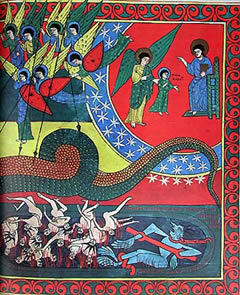 |
Great red dragon with seven heads and ten horns. |
Revelation thus warns about a dramatic reversal in human history because of divine justice. In a Biblical version of "what goes around comes around," God will give back to Rome as she has given. He will "pay her back double for what she has done. Mix her a double portion from her own cup" (18:6).
Revelation also anticipates a comprehensive restoration rooted in divine mercy. In this regard it tracks with Paul's remarks about the redemption of the entire cosmos by a God who is the "Father of every family, in heaven and on earth" (Ephesians 1:14–15; Romans 8:19–22). The Biblical story that began in Genesis with a Fall in a garden ends in Revelation with a restoration in a city. The narrative travels from Eden to the New Jerusalem.
On the last page of the Bible John describes this plot fulfillment as "the healing of the nations," and he imagines nations from around the world streaming to the holy city (21:24, 22:2). In this week's text we read how divine mercy in the New Jerusalem heals all the human degradations of old Rome.
Never again will they hunger;
never again will they thirst.
The sun will not beat upon them,
nor any scorching heat.
And God will wipe away every tear from their eyes (7:16–17).
In the New Jerusalem where all the nations gather there will be no death, no mourning, no crying, or any pain (21:4).
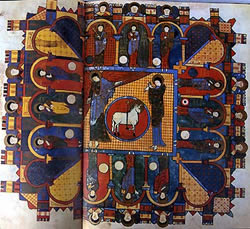 |
The New Jerusalem. |
Although in a few places John refers to the large but limited number of 144,000 Jews, 12,000 from each of the 12 tribes of Israel (7:1), he ultimately expands the scale and scope of the cosmic consummation to include "a great multitude that no one could count, from every nation, tribe, people and language" (7:9). This notion of a limitless ethno-linguistic inclusion is sounded several times (5:9, 11:9, 13:7, and 14:6).
Every tribe, every tear. I recently read about a tribe of 350 people called the Pirahã. Buried deep in a Brazilian rain forest, the Pirahã have fascinated cultural anthropologists and especially linguists. Their language is based upon just eight consonants and three vowels, and according to Dan Everett, one of a very few people who have mastered their language, the Pirahã have "no numbers, no fixed color terms, no perfect tense, no deep memory, no tradition of art or drawing, and no words for 'all,' 'each,' 'every,' 'most,' or 'few.'" But we can say with confidence that the "every tribe and every tear" of Revelation includes the Pirahã as readily as it does ancient Rome or modern America.1
NOTE: All the images this week are of 11th-century illuminated manuscripts of the book of Revelation by Stephanus Garsia Placidus, from the Bibliothèque Nationale de France, Paris.
For further reflection:
* How do you explain the wild success of the Left Behind series about the end times with its sales of 60 million books?
* Can you think of modern-day imperial "Romes?"
* In what sense is empire, Rome or otherwise, the opposite of the kingdom of God as disclosed in Jesus (Borg)?
* Do we too easily dismiss apocalyptic literature as bizarre and void of practical applications?
* What do third world Christians have to teach first world believers about reading the Bible?
[1] John Colapinto, "The Interpreter," The New Yorker, April 16, 2007.





